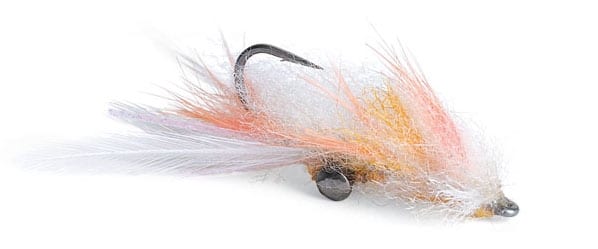
TYING INSTRUCTIONS: THE GHOST WHISPERER
****
One of the most highly regarded live baits used by West Coast surf fishermen is the mud, or ghost, shrimp. Ghost shrimp are mud-eating invertebrates commonly found from southern Alaska to Baja California.
They live and thrive in and along intertidal estuaries, bays and coastal waterways – and they’re also a favorite prey of many inshore species in these areas.
Ghost shrimp prefer living in soft, muddy sand, where they channel, creating dome-shaped mounds that are easily identified during minus low tides. It is during these extreme tidal periods that their volcano-like mounds are exposed to the naked eye.
A Juicy Morsel for Game Fish
Ghost shrimp act similarly to garden earthworms by filtering and burrowing in the mud and helping maintain a healthy balance in the ecology. As filter feeders, they are constantly cleaning and irrigating the bottom. These soft-shell, albino-like crustaceans are translucent and internally colored in pinks, oranges and mustard yellows.
On high tides, when their dwellings are covered, the shrimp are commonly rooted and sucked out of their holes by predators scanning the floor for their telltale entrance holes.
To capture these shrimp, serious surf-bait fishermen use homemade PVC suction pumps that extract the invertebrates from their silted burrows and deposit them where they can easily be collected flopping on the sand.
Fished as live bait, ghost shrimp are often an unparalleled choice when targeting many prize surf species. A free-swimming ghost shrimp skipping along the bottom, isolated from its sand condo, immediately finds itself in a tough neighborhood with no place to hide.
Wool Makes It Right
Tying a realistic-looking ghost shrimp pattern was something I tried to accomplish for quite some time. I wanted to use natural materials that were soft and pliable and colors that matched the ghost shrimp’s mottled appearance.
I started playing with white rams’ fleece as a soft outer covering. The fleece looks transparent when wet. After cutting the wool off the hide and brushing out the loose ends, you can easily pull and tear the wool ends to achieve a natural taper. By enveloping and draping the white wool over the peaches, yellows and oranges of rabbit, you can achieve the internal colors of the shrimp.
The fly is tied in two stages. The first stage centers on the head of the shrimp; you incorporate feelers and feathers and conclude by securing the wraps with Tuffleye or epoxy. The second stage involves the tail of the shrimp. It is tied completely on top of the shank, ending with a tuft of wool that acts as a tail. This tail section runs perpendicular to the shank and is secured and then trimmed in an angle toward the eye of the hook.
Served on a Dinner Platter
This fly was developed primarily for back-bay San Diego, California, bonefish and corvina. Both of these species have been landed on the Ghost Whisperer, as have spotted bay bass, calico bass, sand bass, croaker, mackerel and halibut.
I like to fish this fly on a long tapered leader with a Kreh or nonslip mono loop knot, to impart a more lifelike action to the fly. A nonslip loop knot in combination with a fluorocarbon tippet will keep the fly down in the feeding zone, and a single-handed strip with a slow cadence will allow the fly to skip and bounce along the bottom, where it can be served up on a dinner plate. I hope you are inspired to tie a Ghost Whisperer and swim it in your local waters.









